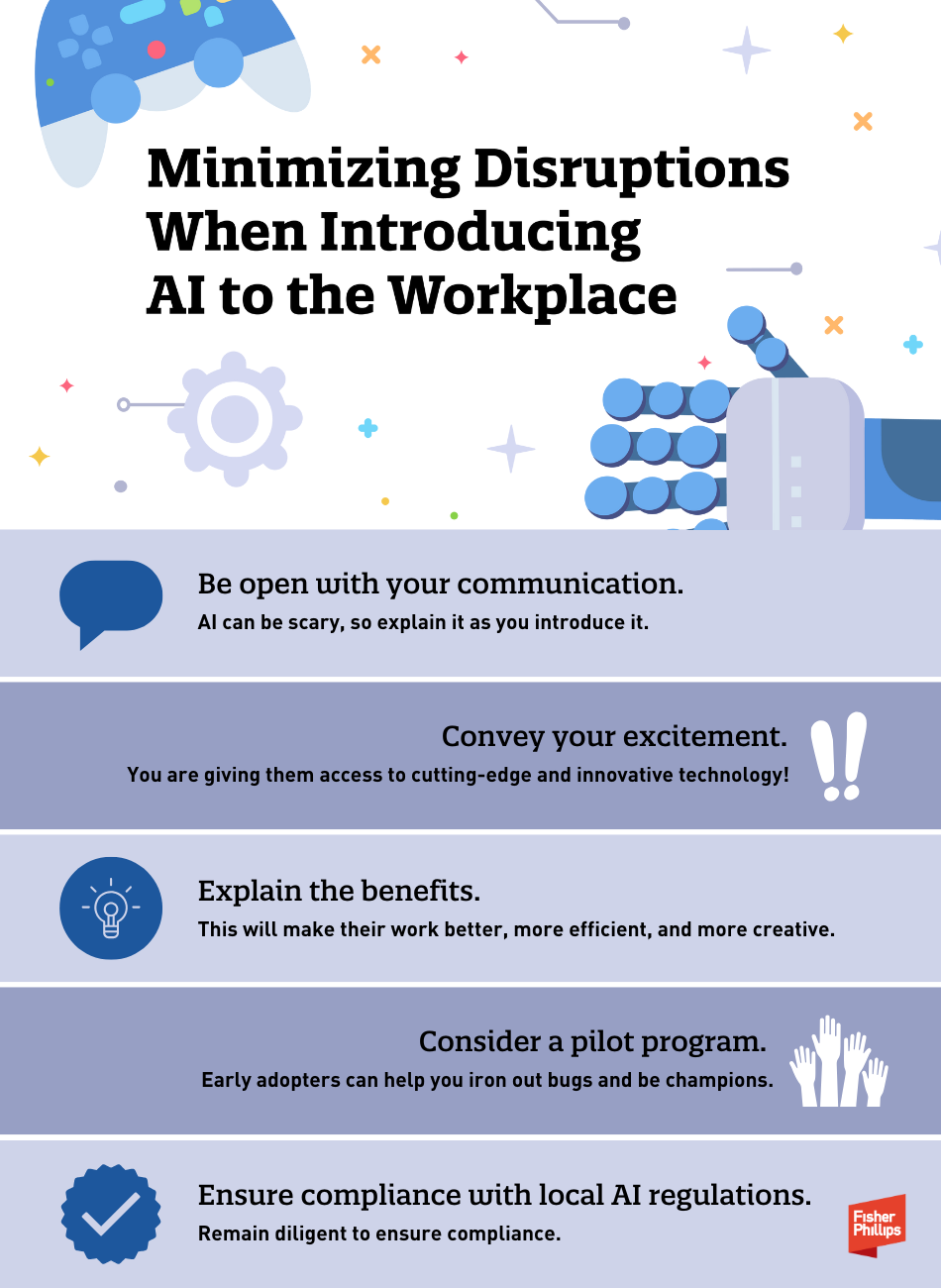Will New AI Digital Replica Laws Lead to “Game Over” for Video Game Actors Strike? What Employers Need to Know
Insights
10.23.24
Two new AI “Digital Replica” laws in California may end up playing a crucial role in resolving a drawn-out labor dispute between video game actors and developers. Video game actors organized by the Screen Actors Guild (SAG-AFTRA) have been on strike since July, with both sides at loggerheads over the use of AI tools in the interactive entertainment industry. But within weeks of the new legislation being signed into law, SAG-AFTRA announced that it will be resuming negotiations with some of the largest video game companies on October 23. As the dispute veers towards a hopeful resolution, we break down what employers should take away from the video game actors strike, as well as the new AI digital replica laws that might have paved the pathway towards its resolution.
What’s Going On?
The video game actors strike is entering its third month as regulations over AI “digital replicas” remain at the forefront of labor negotiations.
- On the one hand, actors (including voice actors and motion capture performers) are concerned that employers will use AI to replace live performances without compensation, transparency, or consent.
- On the other hand, employers believe AI is a vital tool to shorten the gestational period for game development and minimize production costs, a high priority in a year riddled with mass layoffs and studio closures.
Amidst this backdrop, in September 2024 alone, California Gov. Gavin Newsom signed 18 AI bills into law, making AI a moving target for labor negotiations. This wave of AI legislation included two new laws regulating the use of digital replicas – one of the hot button issues at the heart of the video game actors strike.
What Are The New Digital Replica Laws?
AB 2602 (to be codified as Cal. Lab. Code §927), makes digital replica contract provisions retroactively unenforceable if they:
- permit creating and using a digital replica of an individual’s voice or likeness either in place of work the individual otherwise would have performed or to train a generative AI system; and
- do not clearly spell out the proposed uses of the digital replica or generative AI system.
The law targets situations where there is an imbalance of power, such as when the individual who is at risk of losing work because of a digital replica is not represented by legal counsel or a labor union. The party with the power to create or use digital replicas would be required to notify the individual by February 1, 2025, that a prohibited provision is unenforceable.
AB 1836 (to amend Cal. Civ. Code §3344.1) updates current law to prohibit the use of a deceased person’s voice or likeness in digital replicas without the prior consent of their estate. The law imposes statutory damages of either $10,000 or the actual damages suffered (whichever is greater), and removes existing exemptions for film, TV, audiovisual works and more when it comes to digital replication.
How Have These New Laws Impacted the Video Game Strike?
While AB 2602 is primarily intended to regulate the use of AI for non-union members, the bill’s enactment (alongside the enactment of AB 1836) will be seen as a union victory. This may embolden SAG-AFTRA during negotiations over the parties’ collective bargaining agreement, the Interactive Media Agreement (IMA). After all, SAG-AFTRA’s Executive Director has referred to AB 2602 as “one of our top legislative priorities.”
Additionally, the new laws may impact negotiations over how the term “digital replica” will be defined in the IMA. This determination will greatly impact the scope of regulations over AI in the video game industry. Both of the new laws define the term as follows:
a computer-generated, highly realistic electronic representation that is readily identifiable as the voice or visual likeness of an individual that is embodied in a sound recording, image, audiovisual work, or transmission in which the actual individual either did not actually perform or appear, or the actual individual did perform or appear, but the fundamental character of the performance or appearance has been materially altered.
The California legislature’s adoption of this definition may raise concerns for some talent relying on these new laws for protection. Indeed, SAG-AFTRA has objected to the adoption of the above “readily identifiable” language in the IMA because this language creates the following loopholes:
- Voice actors who are rendering or emulating a voice unlike their may fall outside this definition.
- Motion capture actors and stunt performers’ movements may not be “readily identifiable” and may fall outside this definition.
When negotiations reengage, video game employers seeking to minimize regulations over AI may point to the new legislation as a standard for defining “digital replica” for the purposes of the IMA. However, SAG-AFTRA has cited this language as a significant reason for initiating the strike and is unlikely to budge unless the foregoing loopholes are addressed within the IMA.
What Can You Do to Minimize Disruptions?
Whether you are a unionized employer or not, you may be wondering about some best practices to incorporate AI technology into your workplace to minimize potential concerns, disruption, and labor unrest. Here are some tips you can follow to ease the pathway and allay the fears of your workforce:
- Be open with your communication. For some, AI can be scary. Explain to your workers how helpful the specific product you are introducing can be using specific use cases. This is especially true in a unionized environment. Providing notice of the change will at least insulate you from a claim that the change was done unilaterally (which, depending upon the nature of the AI usage, may be done without further bargaining with the union).
- Convey your excitement. Explain that your customers, clients, and business partners expect your business to innovate. By giving them access to this cutting-edge technology, you can show that you are dedicated to provide the best and most innovative services that will help your company thrive.
- Explain the benefits. Don’t shy away from the key message: the tool you are deploying is aimed at making your employees’ work better, more efficient, and more creative. It should help relieve them of some of the drudgery and repetitive tasks and allow them to focus on the fun and engaging stuff. And it has the power to make the finished product far superior for your customers.
- Consider a pilot program. You may want to start the process by selecting a group of early adopters with a positive team-oriented mindset to be test subjects for your product. They can help you identify bugs you can iron out before you roll it out widely and then can be some of your early champions to talk up the product to those more skeptical.
- Ensure compliance with local AI regulations. As evidenced by California’s new digital replica laws that implement hefty violations for noncompliance, AI regulations are likely to present ongoing challenges for employers seeking to integrate AI solutions into their businesses. Employers must remain diligent to ensure compliance with these regulations to avoid costly violations.
Conclusion
If you have questions about the ongoing video game actors strike, related regulations, or the latest developments in tech, reach out to your Fisher Phillips attorney, the authors of this Insight, or any attorney on our Technology Industry Group. We will continue to monitor the ongoing video game strike and the developing legal and regulatory landscape, so make sure you are subscribed to receive Technology Industry updates by signing up through the Fisher Phillips’ Insight system to get the most up-to-date information directly to your inbox.
Related People
-
- Andreas Moghimi
- Associate

